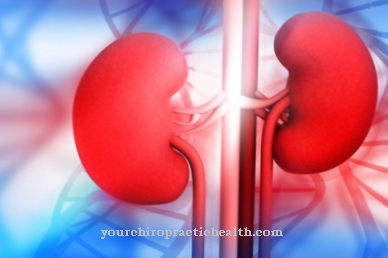The Intercalation is the incorporation of particles such as molecules or ions in certain chemical compounds such as crystal lattices. In biochemistry, the term is associated with the intercalation of particles between neighboring base pairs of the DNA, which can result in grid mutations. The substance thalidomide, for example, has intercalative properties, which caused a malformation scandal.
What is the intercalation?

In chemistry, intercalation is understood as the intercalation of molecules, ions or atoms in chemical compounds. The structure of the particles remains essentially constant during the storage process. In inorganic chemistry, the intercalation primarily refers to the intercalation of particles between the crystal lattice planes of the layer crystals. In this context, the intercalation of an alkali metal in graphite should be mentioned, for example, which creates new compounds in the form of intercalation complexes. Intercalation compounds of crystals require large interaction forces in the layers involved and minimal forces between adjacent layers.
In biochemistry, the term again refers to DNA. During the process, certain molecules insert themselves into the double helix of DNA by squeezing between neighboring base pairs.
The process of biochemical intercalation is not a physiological process. It is a pathophysiological process that disrupts the replication and transcription of DNA.
The intercalation is causally associated with genetic mutations that are predominantly relevant in the replication process. The result is malformations of individual tissues. In addition to the mutagenic properties, intercalation in the biochemical sense is also said to be carcinogenic, i.e. carcinogenic.
The compounds with intercalative potential include, for example, cytostatics that are used in cancer therapy. Using intercalative substances, damage to the DNA is caused during the treatment, which causes the tumor to die.
Function & task
During biochemical intercalation, molecules within the DNA insert themselves into the double helix of neighboring base pairs and disrupt the replication and transcription of the genetic material. In the replication process, intercalation causes primarily raster mutations, which are also known as reading frame mutations, reading frame shifts or frame shift mutations.
During intercalation, (3n + 1) base pairs are inserted, which falsifies the mRNA grid in the DNA. As a consequence, mutated proteins are formed whose amino acid sequence is changed in all positions from the position of the mutation. A stop codon is introduced at an early stage, which ends protein synthesis in terms of translation. Screen mutations towards the end of the reading frame sometimes lengthen the polypeptide because they make it difficult to recognize the physiological stop codon.
Humans benefit from processes of intercalation primarily through cytostatics that are used for cancer treatment. Despite the medical progress of the last decades, cytostatics are still considered to be the most effective treatment method for malignant cancer due to their intercalative properties. The toxic chemical substances are used in chemotherapy and disrupt, delay or prevent the cell cycle of the tumor cells so that the malignant cells no longer spread or spread.
The DNA damage caused by intercalation causes chromosome aberrations or disrupts the development of the spindle apparatus. In this way, the division of the target cells is slowed down or switched off.
The group of cytostatics includes various substances with chemically very different structures. Known intercalative substances of this type are actinomycin, anthracyclines or daunorubicin. Humans also benefit from the principle of intercalation in connection with other drugs. For example, the chemotherapeutic effect of antibiotics is attributed to the intercalation connection.
You can find your medication here
➔ Medicines to calm down and strengthen nervesIllnesses & ailments
Thalidomide corresponds to a glutamic acid derivative that has a dampening effect on the central nervous system and, in addition to immunosuppressive, also has anti-inflammatory effects. The substance is considered to be intercalative.
As thalidomide has a calming, sleep-promoting, inflammation, tumor growth and blood vessel formation inhibiting effect, it was made available to almost every household as Contergan® at the end of the 1950s. Due to its intercalative properties, taking the substance in the first three months of pregnancy leads to the intercalation processes described above, which have dramatic effects on embryonic development. The newborns were born with severe malformations of the limbs or internal organs.
Due to its intercalative properties, the substance blocks the growth factor VEGF, so that the formation of blood vessels in embryonic development is inhibited. Since the embryo reacts particularly sensitively to harmful influences in the first three months of development, in addition to the malformations, it can even lead to loss during this time.
Apart from such devastating consequences, intercalative substances are associated with a carcinogenic, i.e. carcinogenic, effect. This applies, for example, to certain dyes. These include ethidium bromide or EtBr, which in molecular genetics stains nucleic acids. Ethidium bromide has the empirical formula C21H20BrN3 and intercalates between the two DNA strands, so that staining occurs.
Since the dye absorbs UV light in wavelengths from 254 to 366 nm and emits orange-red light with wavelengths of 590 nm, it is irreplaceable as a colorant in molecular genetics. Ethidium bromide stains DNA samples that have previously been separated using an agarose gel. The dye is added to the gel immediately. In this way, the dye binds to the DNA, making the DNA visible in a specific way. Since ethidium bromide is potentially carcinogenic, appropriate safety measures must be taken when using it to prevent direct contact with mucous membranes or skin. The same applies to all other, intercalative substances with carcinogenic effects.



























